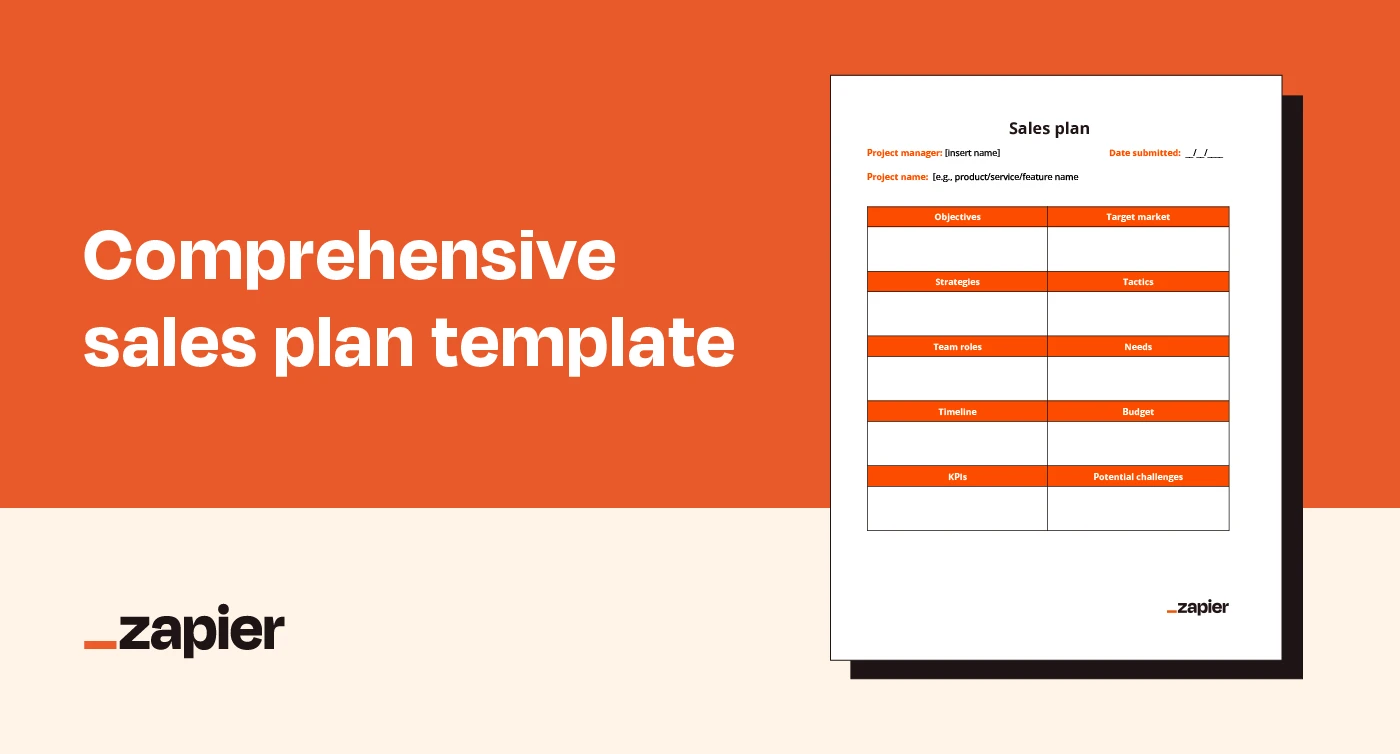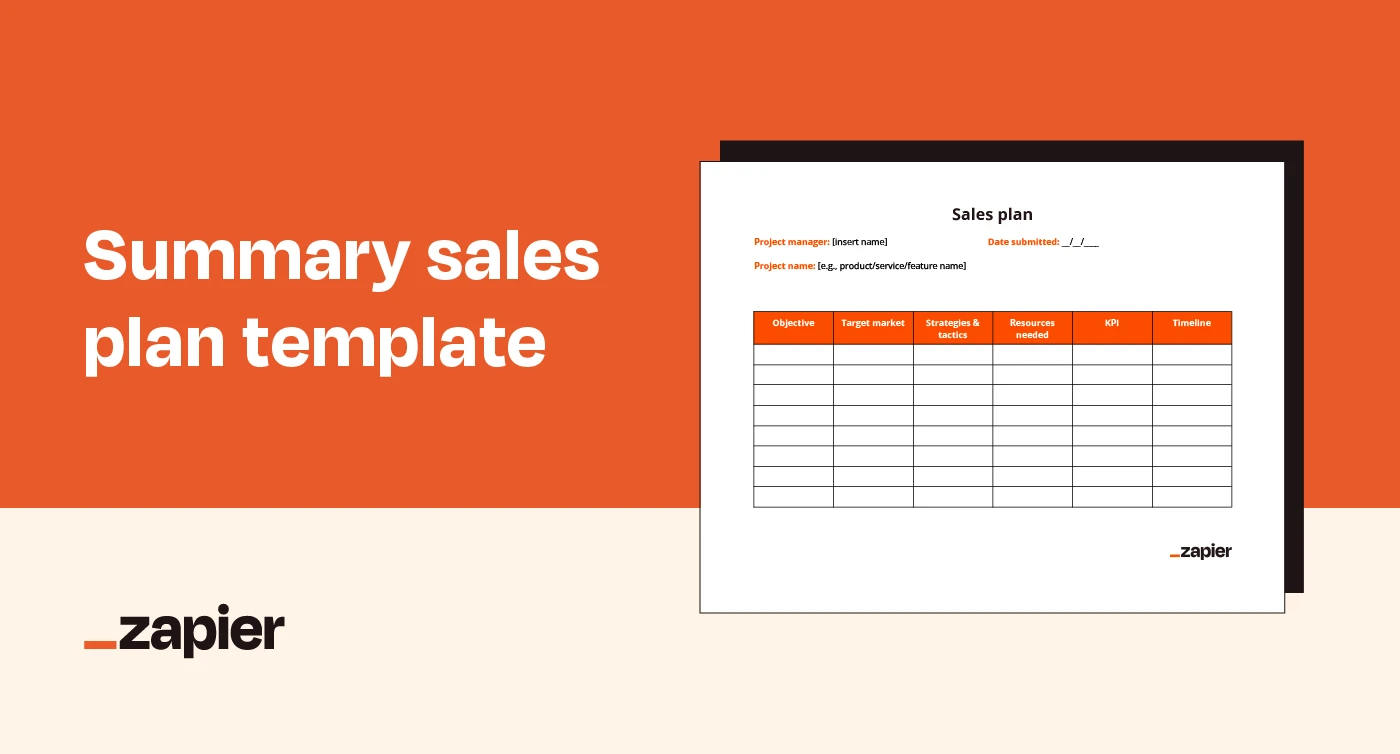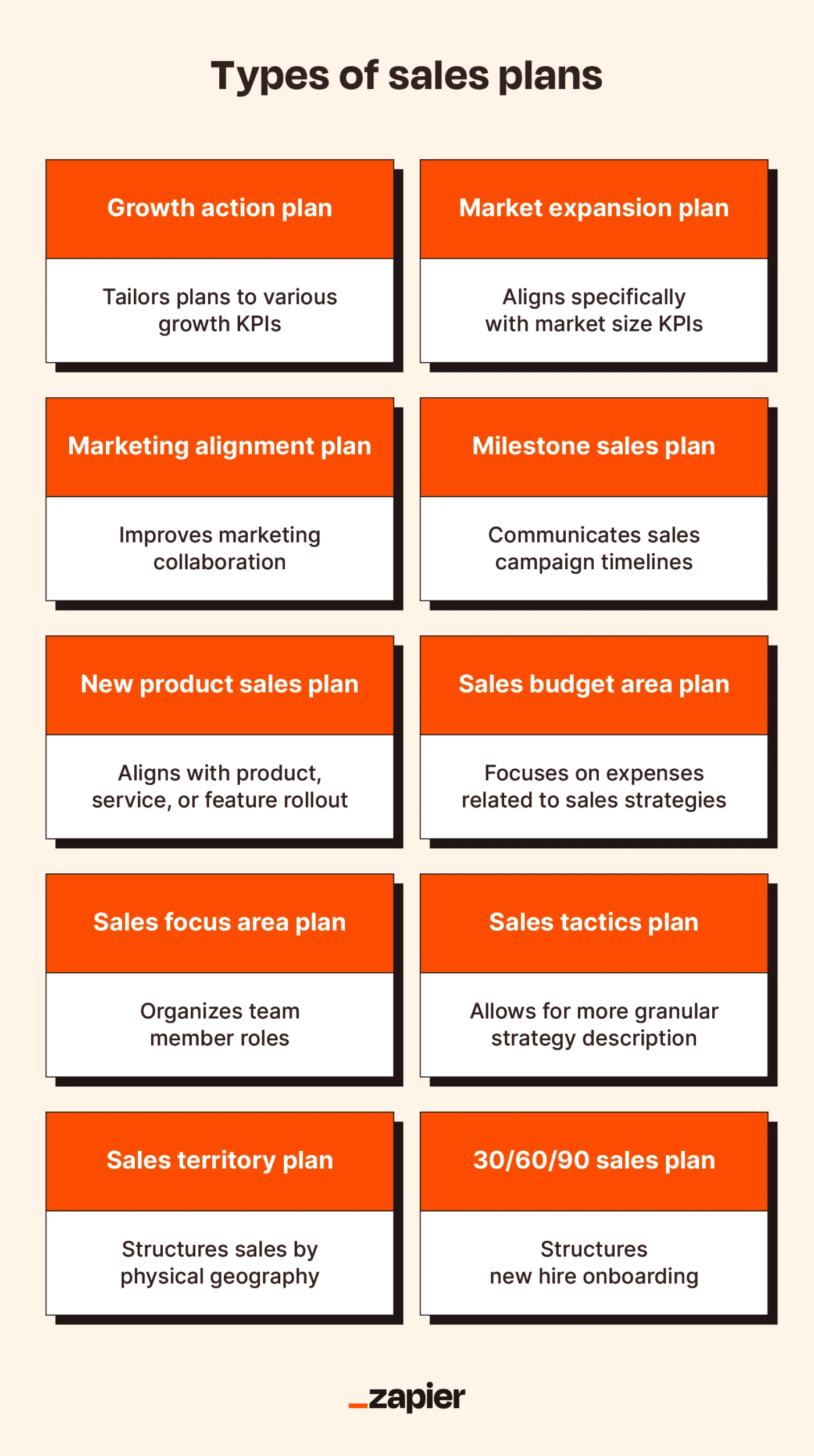There's a 25-year-old "South Park" episode I think about way too often. Working on a presentation with a coffee-addicted classmate named Tweek, the boys see a gnome stealing underpants from Tweek's dresser. They follow him to a cave, where they discover a network of gnomes executing a massive underpants-smuggling operation.
Explaining their business model, the underpants gnomes present this outline:
Phase 1: Collect underpants
Phase 2: ?
Phase 3: Profit
This only slightly oversimplified satirical bit reflects what sales plans too often come down to: offer something, then get money. The reality is that sales success hinges on the research and tactics between those two phases. If you're not sure how to start defining those for your business, this guide should help. (And if it doesn't, our sales plan templates should.)
In this post:
What is a sales plan?
A sales plan is a strategic document outlining goals and strategies for reaching predetermined sales targets. For the "South Park" underpants gnomes, it's the glaring question mark standing between their product and their profits.
These formal documents set the foundation for business objectives and operations, defining everything from target markets to marketing ideas to benchmark reporting to revenue projections. They're thorough enough to communicate nuanced research but concise enough to easily share with stakeholders across an organization.

What goes into a sales plan (including examples)
A sales plan has the information stakeholders need to establish sales goals, set strategies, allocate resources, collaborate across teams, track goal progress, and measure success. Basically, whatever the stakeholders need to make sound decisions about sales processes.
The specific elements of a business plan differ by factors like sales plan type, industry, product type, goal horizon, and organizational structure. Some may have just a few sections across a page or two, others a dozen or more over several pages.
While your sections may differ in number or phrasing, you can expect some version of these elements to go into most sales plans.
Objectives
This section is where you set measurable sales goals. (In fact, this section is also called "Goals" in many sales plans.) Depending on your industry, common sales objectives include:
Total revenue growth
Market share expansion
Customer acquisition volume
Adoption rate increase
Obviously, you could just write "$100 billion" here and insert a Dr. Evil meme, then hope for the best. But the real objective of the objectives section is to come to attainable sales goals that align with broader organizational growth goals.
Example
Increase market share by 5-10% this fiscal year
Target market
If your product is a massive eCommerce space with rock-bottom prices and free next-day shipping, write "Everyone" and move on. But since you're probably not Jeff Bezos, you'll need a detailed description of your ideal customer profile.
By identifying specific segments and demographics, you can focus marketing operations and cater your sales plan to the customers and users most likely to help fulfill your sales goals.
Example
Project managers of midsized technology companies with distributed teams seeking streamlined collaboration and task management
Strategies
This is where you'll give the broad strokes of the approach you'll take to achieve your sales goals with your target market. Whether it's for entering new markets, expanding within existing markets, or launching new products, this generalized section communicates the stepping stones that will lead to your objectives.
Note that this section is related to the tactics section below but isn't as granular. Think of this as a space to describe the high-level strategies, their benefits, and their relation to sales goals and markets.
Example
Improved prospecting, generating more qualified leads, and tailoring sales processes to market research to make existing sales processes more efficient
Tactics
This is where you get down to the proverbial brass tacks with specific actions and campaigns that'll actualize your greater sales strategies. Feel free to go full sales nerd about things like pricing strategy, lead management, and marketing channels.
These tactics are still theoretical and don't have to be set in stone at this phase. But this is a space to describe specifics like customer survey or beta testing methods, social media marketing campaign concepts, new sales techniques, or new ways of utilizing existing sales software and resources.
Example
Leverage social media influencer outreach with influencer-specific promo codes
Team roles
As anyone who's ever watched a heist movie knows, every great plan needs a crack team. In this section, you'll list either each member of your sales team or the team leads, depending on your team size. Beyond a simple list of names, here are some helpful elements to include about each:
Title
Aptitudes or experience
Certifications or completed trainings
Hourly pay rate (for budgeting and forecasting)
Daily or weekly utilization limits
Associated accounts
This should help you outline a structure for assigning individual roles and responsibilities related to your strategies and tactics, ensuring you've got the people power to get the job done.
Example
John Doe, UX specialist | $100/hour incurred expense | 20 hours/week floating utilization | Manager: Jane Doe | Responsible for analyzing survey data and making recommendations for UI updates
Needs
As you develop your strategies, you may find that you don't quite have all the resources you need to bring them to reality. Maybe you need additional sales tools to execute new tactics. Or maybe you need to build extra time into your timelines to create new sales enablement content to prepare your teams.
It's possible you may even need new hires, freelancers, additional trainings, certifications, or third-party agencies to do the things you need to do. List those here, so you can incorporate them into your time and expenses.
Example
CRM for lead management, agency with SEO specialization, freelance digital designer, additional SEO tools
Timeline
Stakeholders won't just want to know what you're going to do—they'll want to know how long it'll take. Outline your strategies by breaking them into key milestones and deadlines according to the personnel you have. This should also map to revenue projections as your strategies mature.
Example
2/15: Complete market research | 3/1: Synthesize findings | 3/15: Schedule strategies for Q2 execution
Budget
The last thing you want is to create a beautiful, perfectly crafted sales plan and discover that you don't actually have the funds to execute it. Based on entries in the last few fields, you should have a good idea of expenses based on strategy resources, personnel utilization, timelines, and any purchases your team may need.
Chart those here with estimates for any other potential expenses related to marketing, advertising, and sales promotion activities.
Example
Market research: $5,000 ($1,250/week salaried personnel, 8 weeks, 50% utilization) | Design assets: $2,000 (freelancer, flat rate) | New AI sales assistant software: $1,188 ($99/month, 12 months)
KPIs
Sure, you've been making sales since you started executing your plan. But how do you know you're making enough sales to justify your efforts?
This is where key performance indicators (KPIs) come into play. By setting these during the sales planning stage, you allow stakeholders to measure the success of individual sales efforts, so you can report on how performance compares to sales targets over time.
If you're not sure where to start, check out this robust list of eCommerce KPIs to get some KPI-speration.
Potential challenges
If sales were easy, every company would be successful. Even at the planning stage, you should be able to see some possible roadblocks on the horizon.
The best plans are realistic enough to be actualized, so be realistic about what might stand in your team's way. Try to get ahead of challenges relating to things like target market sensitivities, general market conditions, internal resources, competition, seasonality, or campaign effectiveness. Then, come up with contingencies, so you're ready for these obstacles if they do arise.
Free sales plan templates
As anyone who manages workflows knows, everything's easier with templates—and a sales plan is no exception. Even if you don't think you need one, a sales plan can help you create more iterative processes, save time for stakeholders, and use automation for both creation and distribution.
Here are three templates for the same general sales plan structure to choose from, depending on the level of granularity and presentation you're looking for.
Sales plan template 1: Comprehensive document

If you're looking to get buy-in for your sales plan from senior stakeholders, you'll need a document that can organize and communicate your research.
This comprehensive sales plan template includes fields for each of the sections outlined above. Just copy it, rename it to your liking, and then click into each field to start filling in the information outlined in this post. (For sections you don't need, just delete or fill with "N/A" and move along.)
Best for: Communicating every element of your sales plan in full detail with (virtually) unlimited space
Sales plan template 2: Summary document

Maybe you need a sales plan template that gets the point across quickly. This one distills the gist of a sales plan into six concise, actionable sections, so you can share the most important elements of every sales objective in one document.
If you need room for more objectives, just copy/paste an empty row.
Best for: Quickly sharing the fine points of a sales plan with only actionable takeaways
Sales plan template 3: Project workflow document

What does your sales plan look like on a day-to-day basis? If you're having a hard time translating that, use this template.
Just include your sequence of objectives and related tasks, include the person they're assigned to, and tweak the date ranges. You can even update the progress graph for each task as you progress through them.
Best for: Organizing tasks, roles, and timelines within a greater sales plan
How to start sales planning
Step 1: Start sales planning. Step 2: ? Step 3: Start selling.
Sales planning may not be that easy, but it doesn't have to be especially complicated, either. It should take enough time and resources to come up with a document that's persuasive and detailed but not so much that it cuts into the real money-making efforts themselves.
Here are a few ways you can set your plan up for efficiency, success, and—maybe most importantly—stakeholder buy-in.
Start with competitor research
The more you know, the better—and that's especially true for sales planning. Good competitive market analysis can set up your entire plan by showing you what success really looks like in the market right now, not just what you hope it can look like.
You may be tempted to start the sales planning process by outlining your objectives and tactics, but competitor research can go a long way in setting the stage for both. This can show you what works, how well it works, and what doesn't work. It can also show you opportunities to fill market gaps your competitors are missing.
You don't have to reinvent the wheel, but it can be very helpful to just reinvent what your competition is doing.
Helpful resource: The best competitor analysis tools
Don't shy away from established frameworks and methodologies
Established things are established for a reason: they work. If your organization doesn't already deploy standardized frameworks like SWOT analyses or lean on a methodology like Agile, consider using one to gain insights into your planning process or streamline it.
Here are a few benefits many of these can potentially bring:
Iterative internal processes
Improved collaboration
Predictable lines of communication between teams
More useful insights from stakeholders
More accurate internal data
More reliable goal-setting
Obviously, the benefits will depend on the types of frameworks and methodologies you use. But the real key to any of them is the ability to standardize some element of the planning process and make collaboration more efficient.
Helpful resource: Reach any goal this year with the SMART system
Collaborate with stakeholders to define success
You may have one definition of success, while your stakeholders have a completely different one. Remember that your objectives and KPIs need to have bases in two realities: the market's and your company's.
It's the job of senior stakeholders to align sales efforts with high-level goals that help keep the entire operation afloat. That means they may have goals in mind that conflict with your market research findings about sales potential. The sales team, on the other hand, may need to help align expectations with market realities.
Successful sales plans keep both parties on the same page. As such, it helps to collaborate before setting sales benchmarks to see what success can look like for all involved parties.
Helpful resource: How to build a KPI dashboard in Excel in 3 steps (with free templates)
Don't forget about operations
Operations is one of the more complex elements of the sales process and can prove to have more volatility—along with a more significant impact—than others. While this may not necessarily apply to SaaS companies, for those with inventory to consider, sales and operations planning (S&OP) is essential.
S&OP helps align sales teams with operations teams to ensure they have the inventory needed to both keep up with demand and promote maximum stocking efficiency. Since inventory can take time and careful scheduling, it's best to get S&OP underway as early as possible. Demand forecasting, for example, is closely related to both sales and inventory projections, so combining these projections early is worthwhile.
Helpful resource: 7 key stages of product development life cycle
Establish clear lines of communication
If all good plans require a team, then all good teams require sound communication.
Since sales campaigns require collaboration between multiple parties and teams, it helps to have open communication channels during the sales planning process. This could mean adopting an Agile workflow and establishing daily Scrum meetings, hosting regular "office hours," or even just checking in with team leads.
While you're setting up these channels, tap them to get more accurate insights into sales planning elements like budgets, assets, and resource needs.
Helpful resource: The best collaboration tools for teams
Types of sales plans
While the sales plan templates in this post are somewhat generically designed for new product or feature launches, there are tons of other types of sales plans you can choose from. Many expand on specific elements already included at a high level in our templates, foregoing some of the other sections that aren't as relevant.
If you know you want your plan to have a more granular focus on specific use cases, you could consider one of these options.

New product sales plan
This details the introduction and promotion of a recently launched or forthcoming product. Similar to the template and example in this post, it can be for a physical product, digital product, or service. It includes general information without getting too bogged down in details.
Best for: General sales planning for new products, services, or features
Milestone sales plan
Prioritizing timelines, this plan delineates sales objectives and targets to be achieved within specific timeframes. Typically, these timelines fall into weekly, monthly, and quarterly milestones. You can list these in a timeline section for any plan, but this plan is structured around those elements.
Best for: A bird's-eye view of the time a sales campaign will take
30/60/90 sales plan
This sales strategy outlines goals and priorities for the first three months of a new hire's tenure, typically focusing on short-term objectives. This can lean toward onboarding milestones to get the new rep up-to-date on sales processes.
Best for: Bringing on new sales reps
Sales budget plan
As a financial framework, this plan details allocated resources for sales activities and expenses to achieve revenue targets. This gets much more granular about the costs associated with sales, making that element of planning its primary focus.
Best for: Communicating nuanced expense figures
Sales tactics plan
Similar to a sales budget plan, a sales tactics plan is mainly concerned with one area of the sales planning process: the tactics. It takes a comprehensive approach to specifying the methods and techniques required to achieve sales goals and overcome challenges.
Best for: Communicating specific details about sales strategies
Sales territory plan
This one makes me think of classic mob movies—two families hashing out their territories in the Bronx over plates of spaghetti. It's a strategic outline of how you'll distribute sales resources within specific geographic areas or customer segments.
Best for: Segmenting sales efforts geographically
Sales focus area plan
This one highlights specific product lines, customer segments, or markets on which the sales team will concentrate their efforts. It helps align sales team members on their individual responsibilities.
Best for: Setting expectations for sales team roles
Market expansion plan
When you use this sales plan, you're taking a strategic approach to broadening the reach of a product or service by entering new geographical areas or targeting additional customer demographics. You can tailor it to go deep on a range of KPIs that suit your specific goals for saturation.
Best for: Planning specifically for market growth KPIs
Marketing alignment plan
Marketing and sales—one hand (or team) washes the other. To help bump that cleaning sesh along, consider one of these plans. They help coordinate strategies, ensuring a solid connection between sales and marketing efforts.
Best for: Aligning sales and marketing teams
Growth action plan
This strategic roadmap details initiatives and steps to foster business expansion, increase market share, and achieve sustainable growth. It includes actionable strategies for making growth-oriented goals a reality.
Best for: Establishing actionable strategies for growth KPIs
Sales planning tips
As you build out your sales plan, you might find that you need a little help. Here are some of our top tips for sales planning:
Know your audience: The sales plan will either be for stakeholders, team members, or both. Write to their level and with the level of detail they need.
Start with SWOT: A SWOT analysis is a great way to get a quick, relevant picture of fundamental sales plan elements like aptitudes, challenges, and opportunities.
Budget carefully: Not every sales plan style includes budgets by default—but don't let this deter you. It's vital to know what you can afford before you start executing your plan.
Vary strategies: To reduce volatility, try to keep your sales tactics varied. This also helps you find the strategies that work best and back them with data.
Continue monitoring: You can't know if you hit your KPIs unless you monitor according to the benchmarks you're tracking.
Automate: Sales automation can help you achieve more with fewer resources, reducing budgets, lightening team loads, and cutting timelines in the process.
Make a (sales) plan to automate
Hopefully this post has you pumped for sales planning—or at least finding a mysterious new three-step business model (or even just watching "South Park").
To make the process easier, remember to use one of the sales plan templates we provided, so you can start the planning phase on the right foot. And when you use Zapier's no-code sales automation, you take sales efficiency to a whole new level. It'll help you do things like adapt and scale your sales processes, remove friction from buyer journeys, and free up sales teams to do more of what they're good at.
Related reading:






